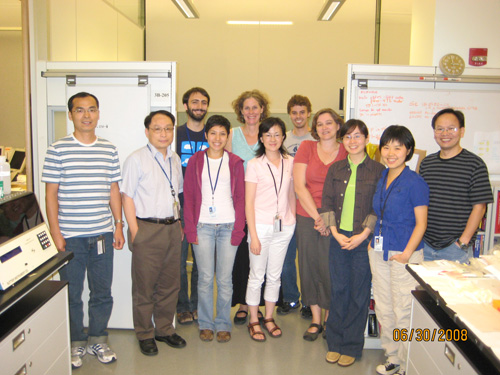| |
| |
| Zu-Hang Sheng, Ph.D., Senior Investigator |
 |
Dr. Sheng received his Ph.D. degree from the University of Pennsylvania where he worked with Roland Kallen and Robert Barchi in cloning skeletal muscle sodium channel genes and studying their regulatory expression. He did his postdoctoral research in the laboratory of William Catterall at the University of Washington studying structural and functional coupling of presynaptic calcium channels and the synaptic vesicle docking/fusion machinery. In November 1996, he joined NINDS as an investigator and in 2007 was promoted to senior investigator. Dr. Sheng's laboratory focuses on the molecular mechanisms underlying neurotransmitter release and its modulation.
|

|
Staff:

- Dr. Qian Cai, M.D., Ph.D., Postdoctoral Fellow, (301) 451-9669 caiq@ninds.nih.gov
- Dr. Yanmin Chen, Ph.D., Postdoctoral Fellow chenyan@ninds.nih.gov
- Ms. Claudia M Gerwin, B.S., Research Assistant, (301) 435-8131 gerwinc@ninds.nih.gov
- Dr. Jian-Sheng Kang, Ph.D., Postdoctoral Fellow jiankang@ninds.nih.gov
- Dr. Miriam Leenders, Ph.D., Postdoctoral Fellow, (301) 435-9668 leendersm@ninds.nih.gov
- Dr. Pin-Yue Pan, M.D., Graduate Student panpi@ninds.nih.gov
- Mr. Anthony J Simone, B.A., Postbaccalaureate IRTA simoneaj@ninds.nih.gov
- Ms. Katherine Elyse Tsubota, B.S., Postbaccalaureate IRTA tsubotak@ninds.nih.gov
- Dr. Yi-Bing Zhu, M.D., Graduate Student zhuyi@ninds.nih.gov
Research Interests:
The formation of new synapses or remodeling of existing synapses requires the targeted delivery of synaptic components. Presynaptic components, including active zone (AZ) precursors, mitochondria, and proteins responsible for the assembly of synaptic vesicle (SV) fusion machines, are transported to the nerve terminal by kinesin motors moving along microtubules. Upon arrival at the terminal, cargo-loaded transport vesicles undergo fusion with the plasma membrane to assemble AZs and to recruit SVs. Docked and primed SVs are then available for exocytosis in response to a rise in intracellular [Ca2+] triggered by the opening of voltage-gated Ca2+ channels. Proper synaptic function requires the tight coordination of these processes.
Our long-term research goals aim to elucidate molecular and cellular mechanisms underlying (1) the axonal transport of synaptic components and organelles essential for the assembly of synapses and activity-dependent presynaptic plasticity; and (2) the regulation of SV priming for fusion. Such mechanisms are crucial for the initial establishment of presynaptic terminals and for the modulation of synaptic function. Using a combination of state-of-the-art live cell imaging, molecular biology, biochemistry, cell biology, and electrophysiology, we have identified three new proteins named Snapin, syntaphilin, and syntabulin. With the generation of knockout mice, the physiological roles of Snapin in priming SV for fusion and syntaphilin in controlling the motility of axonal mitochondria are being revealed. Using live cell imaging combined with multiple loss-of-function approaches we are providing a critical assessment of syntabulin�s role in the trafficking of AZ components for the assembly of presynaptic terminals and for the activity-dependent synaptic plasticity. We will continue to combine our effective approaches using multi-disciplinary systems analysis of genetically engineered mice. Our studies will yield fundamental information that may have an impact on the understanding of neurodegenerative disorders with defective trafficking processes.
|
Selected Recent Publications:
Ping-Yue Pan, Jin-Hua Tian, Zu-Hang Sheng (InPress) Snapin facilitates the synchronization of synaptic vesicle fusion, Neuron.
Jian-Sheng Kang, Jin-Hua Tian*, Ping-Yue Pan*, Philip Zald, Cuiling Li, Chuxia Deng, and Zu-Hang Sheng (2008) Docking of Axonal Mitochondria by Syntaphilin Controls their Mobility and Affects Short-term Facilitation (*equal contribution), Cell 132, 137-248.
Full Text/Abstract
AG Miriam Leenders, Lin Lin, Li-Dong Huang, Claudia Gerwin, Pei-Hua Lu, and Zu-Hang Sheng (2008) The Role of MAP1A Light Chain 2 in Synaptic Surface Retention of Cav2.2 Channels in Hippocampal Neurons, Journal of Neuroscience 28, 11333-11346.
Full Text/Abstract
Qain Cai, Ping-Yue Pan, and Zu-Hang Sheng (2007) Syntabulin-kinesin-1 family 5B-mediated axonal transport contributes to activity-dependent presynaptic assembly, Journal of Neuroscience 27, 7284-7296 (With Weekly Editorial News).
Full Text/Abstract
Qian Cai, Claudia Gerwin, and Zu-Hang Sheng (2005) Syntabulin-mediated anterograde transport of mitochondria along the neuronal processes, Journal of Cell Biology 170, 959-969.
Full Text/Abstract
Jin-Hua Tian, Zheng-Xing Wu, Michael Unzicker, Li Lu, Qian Cai, Cuiling Li, Claudia Schirra, Ulf Matti, David Stevens, Chuxia Deng, Jens Rettig, and Zu-Hang Sheng (2005) The Role of Snapin in Neurosecretion: Snapin Knockout Mice Exhibit Impaired Calcium-dependent Exocytosis of Large Dense-core Vesicles in Chromaffin Cells, Journal of Neuroscience 25, 10546-10555 (With Weekly Editorial News).
Full Text/Abstract
Qian Cai*, Qingning Su*, Claudia Gerwin, Carolyn L. Smith, Zu-Hang Sheng (2004) Syntabulin: a microtubule-associated protein implicated in syntaxin trafficking in neurons , Nature Cell Biology 6, 941-953 (with news & views)(*equal contributions).
Full Text/Abstract
All Selected Publications
Contact Information:
Dr. Zu-Hang Sheng
Synaptic Function Section, NINDS
Porter Neuroscience Research Center
Building 35, Room 3B-203
35 Convent Drive, MSC 3701
Bethesda, MD 20892-3701
Telephone: (301) 435-4596 (office),
(301) 435-8131 (laboratory),
(301) 480-5763 (fax)
Email: zsheng@codon.nih.gov
|
|















